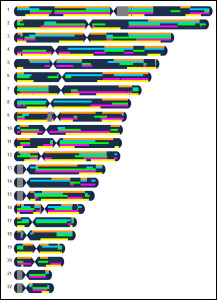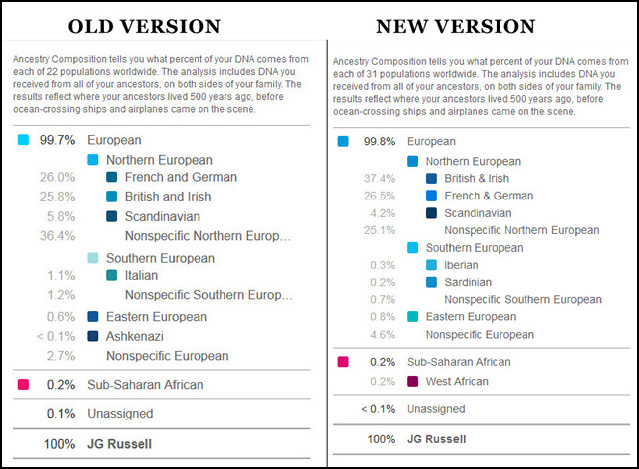Who you are — and aren’t
Both Family Tree DNA and 23andMe rolled out updated tools for reviewing autosomal DNA results this past week — a new matrix tool at Family Tree DNA and a modified Ancestry Composition at 23andMe. Both are well worth taking a look.
The matrix
The new matrix tool at Family Tree DNA is a quick and easy way to visually present information about your matches. It’s not so much that it’s new information as that it’s much faster to get to it than before.
What it does is allow you to compare up to 10 of your matches at a time to see if they are or are not matches not just to you but also to each other.
This is important because, with autosomal DNA, we’re looking at cousins from every part of our family tree1 — unlike YDNA, where we’re looking only at the male line and a father’s father’s father,2 or mitochondrial DNA (mtDNA), where we’re looking only at the female line and a mother’s mother’s mother.3 And figuring out which branch of the family tree is important — and not easy.
Here’s a good example of why this can be a real help.
 Take a look, here at the left, at the chromosome browser results for five of my closest matches — all very close family members (click on the image to open a bigger copy in a new window). Look at the way these segments all overlap and even often start and stop in what looks like the same places. Looking just at this tool, you could sure be forgiven for thinking all five are not only related to me but to each other.
Take a look, here at the left, at the chromosome browser results for five of my closest matches — all very close family members (click on the image to open a bigger copy in a new window). Look at the way these segments all overlap and even often start and stop in what looks like the same places. Looking just at this tool, you could sure be forgiven for thinking all five are not only related to me but to each other.
Not so.
Four of them are; they are my mother’s siblings, two uncles and two aunts. But one — the last one, shown in yellow — is not. He is my paternal half-brother, related to me only on my father’s side. And since my very last of my mother’s ancestors arrived in America before 1800 — and the very earliest of my paternal ancestors who came here didn’t arrive until 1925 — there is no chance of any common lines between my maternal and paternal sides.
Now there have long been ways to check this out at Family Tree DNA. You could do an “in common with” check for each person to see which ones did and didn’t match each other. But this new tool makes it very fast and very easy, and presents it in a compelling visual style.
So when you put these five people into the matrix, here’s what you see:

Pretty easy to see that my Geissler side isn’t related to my Cottrell side, isn’t it?
Way to go, Family Tree DNA!
The percentages
Meanwhile, over at 23andMe, without any fanfare, a modified Ancestry Composition is in the process of being rolled out that changes some of the percentages in the reported ethnicities of those who’ve tested.
Predictably, some of the results are unexpected. Predictably, there are complaints and questions from those whose numbers have changed. Predictably, despite The Legal Genealogist‘s best efforts, people want to believe these numbers rather than regarding them as what they are — cocktail party conversation.4
But at least for me, this time, the changed numbers aren’t all that much of a disappointment.
Oh I did lose my somewhat-less-than-0.1% Ashkenazi, which is a disappointment. (It was one of the few parts of my ethnic makeup that wasn’t downright boring.) But I kept my Sub-Saharan African — my whopping big 0.2% — and it’s now identified specifically as West African. And I’ve picked up some small bits of Iberian in the new numbers, even in the standard projection.
But what I find most intriguing about the change is that 23andMe continues to have no difficulty finding what I would expect to find, my mother’s British and Irish (Scots-Irish, really) and my father’s French and German.5 As a matter of fact, it’s having an easier time identifying those now than before:

Now these numbers are in what’s called the speculative view. But even in the standard view, 23andMe’s estimate went up from 9.4% British and Irish to 12.6%, and from 6.4% French and German to 14.9%. And its estimate of my Scandinavian ancestry went down, even in the standard view, from 1.4% to 0.2%.
Which is exactly the opposite of what happened at AncestryDNA.6
Which is why I keep saying… and saying… and saying… please don’t rely on these percentages.
SOURCES
- See generally Judy G. Russell, “Autosomal DNA testing,” National Genealogical Society Magazine, October-December 2011, 38-43. ↩
- See ISOGG Wiki (http://www.isogg.org/wiki), “Y chromosome DNA test,” rev. 7 Dec 2013. ↩
- See ISOGG Wiki (http://www.isogg.org/wiki), “Mitochondrial DNA tests,” rev. 7 Dec 2013. ↩
- Judy G. Russell, “Those pesky percentages,” The Legal Genealogist, posted 27 Oct 2013 (https://www.legalgenealogist.com/blog : accessed 14 Dec 2013). ↩
- My father’s ancestry is 100% German as far back as we can find. So no comment about the French here. And I’ll even forego the usual joke about the reason the French plant trees is so the Germans can march in the shade. ↩
- See Judy G. Russell, “DNA disappointment,” The Legal Genealogist, posted 15 Sep 2013(https://www.legalgenealogist.com/blog : accessed 14 Dec 2013). ↩



Judy,
I want to let you know that your blog post is listed in today’s Fab Finds post at http://janasgenealogyandfamilyhistory.blogspot.com/2013/12/follow-friday-fab-finds-for-december-20.html
Have a wonderful weekend!
Thanks so much, Jana!